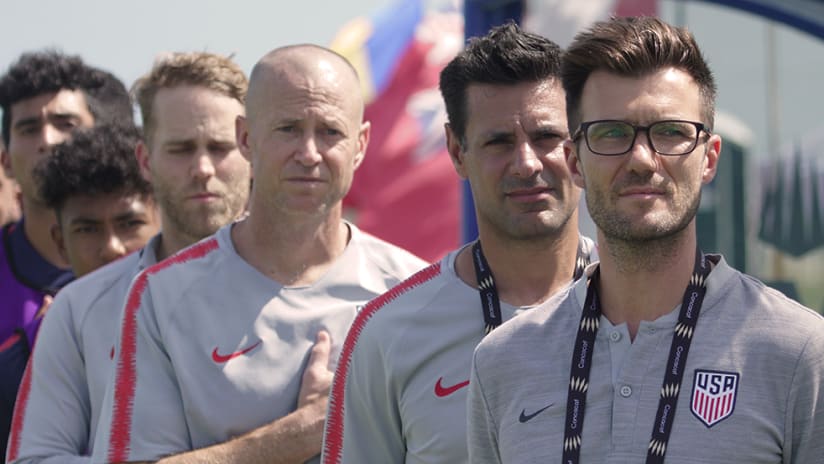While it’s appropriate to add a caveat to any analysis about the US or Canadian performances at the Under-17 World Cup – the players are teenagers, winning isn’t quite as important at this level, it’s about development and not results – the respective federations can’t be happy about each team’s respective weeklong trip to Brazil.
It’s easy to overreact for each program in the wake of the tournament. But it’s a reality check for both federations in terms of the level of player being produced in the United States and Canada compared to the rest of the world.
Problems for the US
The US finished with one point from a possible nine, scoring a goal in the third minute of the first group-stage game against Senegal, and then failing to find the back of the net the rest of the tournament. Head coach Raphael Wicky and the players alike seemed to be shell-shocked and unable to raise their game after impressing with a slick style of play at the Concacaf Championship. Naïve defending proved costly in the opening game against Senegal. An improved shift against Japan saw the US keep a clean sheet, but fail to threaten the goal on a regular basis in a 0-0 draw.
With a point under their belt, progress to the Round of 16 would be secured with a win against a Netherlands side that had conceded six goals and had zero points heading into the final match. After giving up a goal late in the first half, things unraveled for Wicky and the US, as they conceded three times after the break. It could’ve been much worse if not for a few impressive saves from Chituru Odunze, including a penalty kick.
There were many factors at work that made this tournament more difficult than it needed to be for the federation. Wicky was hired late in the process, a month prior to the Concacaf qualifying tournament. Prior to that, the group went through several coaches, from Dave van den Bergh to John Hackworth and Shaun Tsakiris. This cycle marked the first time since the Residency Program had been closed by the federation.
While the group impressed at Concacaf qualifying, it’s now clear that the level there was nowhere close to good enough to provide adequate preparation. In fact, the region’s four teams at the U-17 World Cup (Mexico and Haiti were the other two) have posted a combined record of 1-9-2, scoring 15 goals and conceding 25. Those numbers are inflated by Mexico’s 8-0 win against the Solomon Islands, who gave up 20 goals in their three group games.
But even considering those mitigating factors, player performances were at a concerning level for the United States. It’s easy to nitpick a coach’s roster selection in hindsight, and there’s also the argument that perhaps the US 2002s simply weren’t at a high enough level – which itself points back to the player development and identification process.
Canada come up empty
On the other side, Canada entered this tournament without a win at previous U-17 competitions – and left Brazil empty-handed. Defensive issues saw the Canadians fall 4-1 to Brazil, and by a 2-1 score against a solid Angola side. New Zealand offered a final chance for three points, and an opportunity to keep themselves in the mix to possibly advance as one of the four best third-place finishers.
While falling 1-0 to the Kiwis left Canada with three losses in Brazil, they could take heart from the performance. Canada outshot New Zealand 15-5, including directing 10 on target. They conceded a goal from a long-distance free kick, and had a Jayden Nelson goal chalked off for a marginal offside call early in the buildup. Not to mention a great performance from Kiwi goalkeeper Alex Paulsen.
One solid performance can’t mask the issues that popped up in the other games, however, even if a matchup against Brazil on their home turf was always going to be tough. There was a chance for this Canadian group to make a bigger mark, and while the team showed flashes – they did get two goals from Jacen Russell-Rowe, against Angola and Brazil – in the end there wasn’t enough consistency or quality to get the program’s first win at a U-17 championship.
Takeaways
Obviously, the overall “success” of these two teams won’t be known in the short term. If both teams had dazzled, playing expansive soccer and gone on a deep run, it means little if there is a dearth of prospects moved on to the full team a few years on. If the likes of Jayden Nelson, Jacen Russell-Rowe, or another veteran from this group suit up for the full Canadian men’s team one day, it’s a success.
From the US side, if Giovanni Reyna, Kobe Hernandez or George Bello make the jump, few will remember how poor the US fared here. It’s worth pointing out that Christian Pulisic and Tyler Adams featured for the US U-17s at a World Cup in 2015, also exiting in the group stage.
But at the very least, both federations should do some soul-searching about the development and player identification process in light of the past week’s struggles. To overreact about it is too strong, but it would be neglect to sweep aside any concerns that are very clearly a part of the development process.













